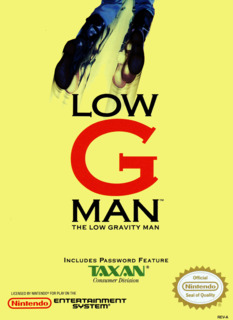Strap on an anti-gravity backpack, arm your electromagnetic disruptor pistol, sharpen your spear, and save humanity.
As Low G Man, you traverse a planet that is controlled by aliens who are determined to annihilate humanity. Your mission is to destroy the aliens’ robots, kill the aliens, and save the day. The mech, spider, and hovercraft vehicles make saving the day much more fun. Like Chewbacca in Return of the Jedi, get atop a mech, kill the operator, hop into the driver’s seat, and start blasting. But unlike the Empire’s AT-STs, the mechs in Low G Man can jump. I’m not talking about little bunny hops. These mechs can soar two screens high.
Controlling the spider is just as fun as controlling the mech. As you might have guessed from reading the vehicle’s name, the spider allows you to crawl along ceilings. What you might not have guessed is that the spider is a powerhouse that obliterates boomerang-hurling aliens, shield-wielding robots and all other enemies by just touching them. Unfortunately, the spider is underutilized. In the too-few areas where a spider is available, the areas don’t seem to be designed with the spider in mind. Disappointingly, you aren't required to use the spider’s ceiling-crawl ability to proceed through any of the levels. You can ignore every spider if you want to. The game designers should have created an entire level in which you have to use the spider to proceed by switching frequently between the floor and the ceiling.
Each vehicle has a limited supply of gas, so you’ll be slaughtering most of the planet’s misanthropes while you’re on foot. But don’t fret; using a powered-up Low G Man is just as effective as using any vehicle. While you’re on foot, you can, for instance, freeze the flying robot-head Forceface by shooting it with your electromagnetic disruptor pistol. Then jump atop the mechanical monstrosity and skewer its circuits with a downward thrust from your spear.
With all of the robot-freezing and spear-thrusting, the gameplay is great. The graphics, however, are only mediocre. Some enemies are so indistinct that I was sometimes wondering what the heck they were supposed to be. And in a couple of instances, I actually mistook a harmless floating platform for an enemy.
The game’s graphics might not be visually appealing, but the cover art is. During the NES era, cheesy, overdone cover art (like the cover art used for 1990’s Clash at Demonhead) was often used for science-fiction games, but the artist for Low G Man used a more subtle approach. Instead of depicting a typical blaster-wielding warrior battling aliens, Low G Man’s cover art simply shows Low G Man’s boots and the lower parts of his legs. The top of the box cuts off the rest of his body. The motion lines around his boots convey the sense that he has just jumped out of the picture.
The design for the cover was financially risky because it probably didn’t appeal to the target audience, young males, who were accustomed to seeing musclebound, machinegun-toting warriors who resembled heroes from popular ’80s movies like Predator and First Blood (the covers of Ikari Warriors and Contra depict heroes of that ilk). But thankfully, the artist for Low G Man dared to defy the norm and gave us one of the most refreshing pieces of NES cover art.
Boost your NES library by adding Low G Man.

